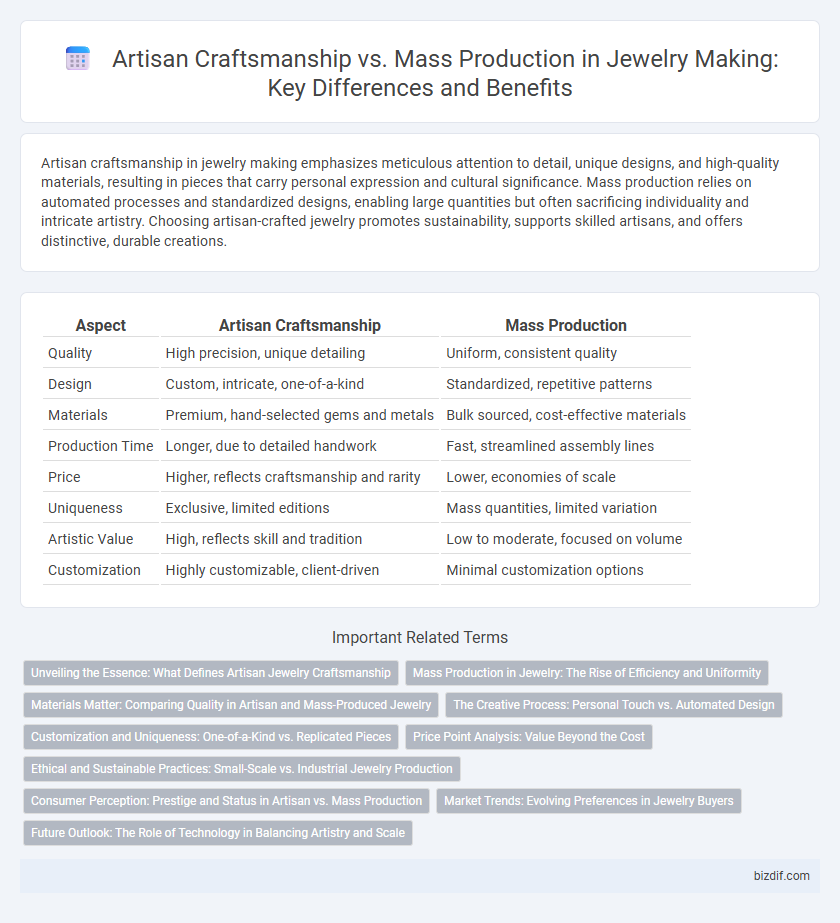Artisan craftsmanship in jewelry making emphasizes meticulous attention to detail, unique designs, and high-quality materials, resulting in pieces that carry personal expression and cultural significance. Mass production relies on automated processes and standardized designs, enabling large quantities but often sacrificing individuality and intricate artistry. Choosing artisan-crafted jewelry promotes sustainability, supports skilled artisans, and offers distinctive, durable creations.
Table of Comparison
| Aspect | Artisan Craftsmanship | Mass Production |
|---|---|---|
| Quality | High precision, unique detailing | Uniform, consistent quality |
| Design | Custom, intricate, one-of-a-kind | Standardized, repetitive patterns |
| Materials | Premium, hand-selected gems and metals | Bulk sourced, cost-effective materials |
| Production Time | Longer, due to detailed handwork | Fast, streamlined assembly lines |
| Price | Higher, reflects craftsmanship and rarity | Lower, economies of scale |
| Uniqueness | Exclusive, limited editions | Mass quantities, limited variation |
| Artistic Value | High, reflects skill and tradition | Low to moderate, focused on volume |
| Customization | Highly customizable, client-driven | Minimal customization options |
Unveiling the Essence: What Defines Artisan Jewelry Craftsmanship
Artisan jewelry craftsmanship is defined by meticulous handwork, unique design elements, and the use of high-quality materials that reflect the maker's skill and creativity. Each piece embodies individuality, often incorporating traditional techniques such as hand engraving, stone setting, and metal shaping, which cannot be replicated in mass production. Unlike factory-made jewelry, artisan pieces emphasize authenticity, attention to detail, and emotional value, making them timeless treasures.
Mass Production in Jewelry: The Rise of Efficiency and Uniformity
Mass production in jewelry has revolutionized the industry by enabling rapid creation of large quantities with consistent quality, using advanced machinery and automated processes. This approach reduces costs significantly and meets high consumer demand through standardized designs and uniform craftsmanship. Despite sacrificing some uniqueness, mass production ensures precision, scalability, and accessibility for a broad market, reshaping contemporary jewelry manufacturing.
Materials Matter: Comparing Quality in Artisan and Mass-Produced Jewelry
Artisan craftsmanship utilizes high-quality, often ethically sourced materials such as 18K gold, natural gemstones, and hand-pressed enamel, ensuring durability and unique character in each piece. In contrast, mass-produced jewelry frequently incorporates base metals, synthetic stones, and lower-grade alloys to reduce costs, resulting in less longevity and a uniform appearance. The material selection in artisan jewelry directly contributes to superior craftsmanship, enhanced aesthetic appeal, and lasting value compared to mass-produced alternatives.
The Creative Process: Personal Touch vs. Automated Design
Artisan craftsmanship in jewelry making emphasizes a personal touch through hands-on techniques, resulting in unique, intricately designed pieces that reflect the maker's creativity and skill. Mass production relies on automated design and machinery to produce uniform items quickly and cost-effectively, often sacrificing individuality and detailed artistry. The creative process in artisanal work fosters originality and customization, while automated production prioritizes efficiency and consistency.
Customization and Uniqueness: One-of-a-Kind vs. Replicated Pieces
Artisan craftsmanship delivers unparalleled customization, creating one-of-a-kind jewelry pieces that reflect individual artistry and client vision. Mass production prioritizes efficiency and consistency, often resulting in replicated designs with limited personalization options. The unique nuances found in handcrafted jewelry offer distinct value that machine-made items cannot replicate.
Price Point Analysis: Value Beyond the Cost
Artisan craftsmanship in jewelry making commands higher price points due to the meticulous handwork, unique designs, and superior materials that contribute to its long-term value and exclusivity. In contrast, mass production lowers costs through automated processes and bulk material sourcing but often sacrifices individuality and detailed quality. Consumers investing in artisan pieces gain lasting aesthetic and emotional value that extends beyond the initial price tag, positioning artisan jewelry as both a luxury and a collectible.
Ethical and Sustainable Practices: Small-Scale vs. Industrial Jewelry Production
Artisan craftsmanship in jewelry making emphasizes ethical sourcing of materials and sustainable practices, often utilizing recycled metals and conflict-free gemstones to minimize environmental impact. Small-scale production supports local economies and reduces carbon footprints by limiting large-scale resource consumption and waste generation. Industrial jewelry production tends to prioritize high-volume output, frequently relying on less transparent supply chains and mass extraction methods that can contribute to ecological degradation.
Consumer Perception: Prestige and Status in Artisan vs. Mass Production
Consumer perception significantly elevates artisan-crafted jewelry as a symbol of prestige and exclusivity, associating unique, handcrafted pieces with higher cultural and monetary value. Mass-produced jewelry, while accessible and consistent in quality, often lacks the distinctiveness and emotional connection that define artisan creations, leading to a perceived lower status among discerning buyers. The artisan approach emphasizes individuality and heritage, fostering a sense of luxury that mass production cannot replicate.
Market Trends: Evolving Preferences in Jewelry Buyers
Artisan craftsmanship in jewelry is increasingly favored by buyers seeking unique, customizable pieces that reflect personal stories and sustainable practices. Market trends indicate a growing demand for ethically sourced materials and limited-edition collections, contrasting with the uniformity and environmental concerns associated with mass production. This shift is driving jewelers to emphasize handcrafted techniques and transparency in their supply chains to meet evolving consumer preferences.
Future Outlook: The Role of Technology in Balancing Artistry and Scale
Advancements in 3D printing and computer-aided design (CAD) are revolutionizing jewelry making by enabling artisans to maintain intricate craftsmanship while scaling production efficiently. Artificial intelligence aids in optimizing design processes, ensuring unique, customizable pieces meet growing market demands. Integrating smart manufacturing technologies preserves the artistry's authenticity while expanding accessibility and sustainability in the industry.
Artisan craftsmanship vs Mass production Infographic

 bizdif.com
bizdif.com